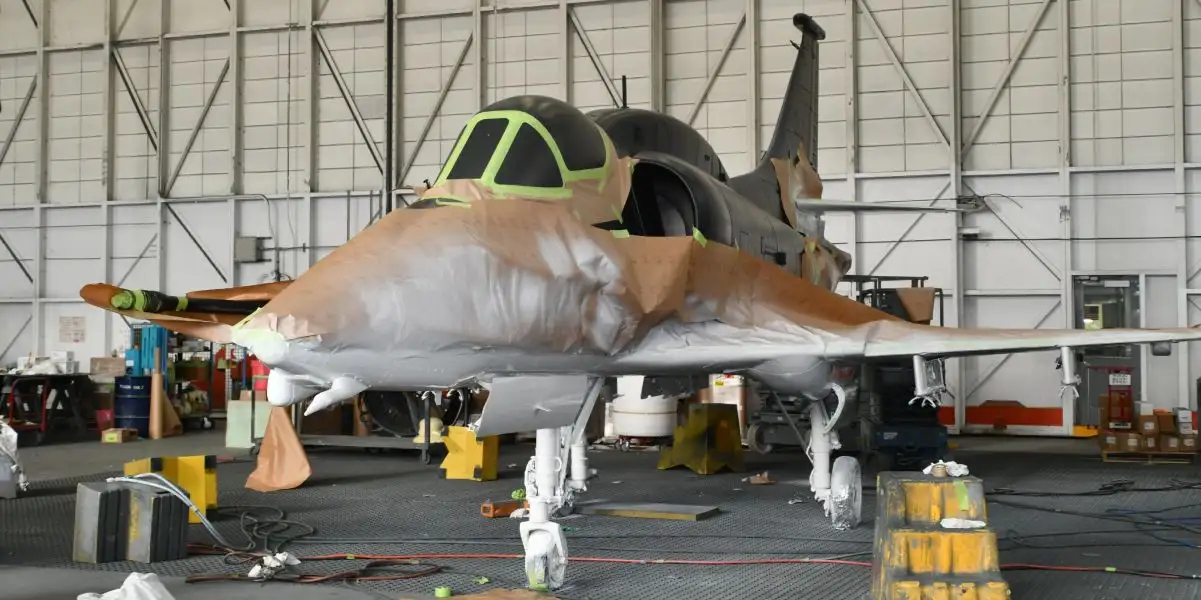Douglas A-4M Skyhawk restored to its former glory
Marine Corps Air Station (MCAS) Cherry Point, North Carolina, artisans at the Fleet Readiness Center East (FRCE) recently had the exceptional chance to restore a piece of aviation history for display on MCAS Cherry Point.
FRCE’s Aircraft Clean and Paint shops prime and paint every aircraft that comes through the facility because it is an aviation maintenance, repair, and overhaul facility. However, when they brought a retired Douglas A-4M Skyhawk back to life, artisans got the opportunity to “travel back in time”—the platform hasn’t been used by the depot in over 20 years.

For many FRCE artisans, such as aircraft painter Kirby Mills, working on the A-4 was a first because the Navy retired its last A-4 Skyhawk in 2003, which was 21 years ago.
“I’ve done a few restorations for display aircraft, but this is the first A-4 I’ve seen come through here,” said Mills in a NAVAIR news release. “I had never worked on an A-4 before. It was very neat and it’s nice to see it put to use.”

A-4M Skyhawk restored for historical display
FRCE had previously maintained an A-4, even though this was the depot’s first restoration of an A-4 Skyhawk for historical display. FRCE serviced A-4s from 1989 to 1996, the year the A-4 platform was retired. A-4s returning to the depot gave Stephen T. Gurley, the branch head of the Fleet Support Team’s Critical Item Management Team at FRCE, the impression that he had traveled back in time.

“The A-4 platform was the first aircraft platform I worked on at FRC East in 1991, and I spent a lot of time working on them,” said Gurley. “I traveled to different squadrons all throughout the ‘90s to repair A-4s, and now to hear about this, it’s exciting. It brings back memories.”
The first A-4
According to planner Jeffrey Mitchell of the Aircraft Transfer Branch, this project is special because of its distinctive paint scheme.

“This is the fourth historical aircraft we have done for the air station, but the first A-4,” said Mitchell. “This project was chosen to honor Marine Attack Squadron 223 here on base, who flew the A-4 until ’87 when they received their first McDonald-Douglas AV-8.”
Mitchell and his team looked for additional help because of the A-4’s historical ties, even though FRCE’s Aircraft Paint Shop offers paint schemes for the aircraft the depot services.
“We worked with historians at Marine Attack Squadron 223 for this aircraft’s paint scheme as the squadron is still stationed here,” said Mitchell. “We were able to get pictures and ideas from them, they were very helpful; we wanted to make this aircraft look like it did back in the day.”

Creative freedom with paint scheme
According to Mills, the nature of the restoration allowed them to personalize the aircraft’s paint scheme.
“It was nice to have a bit of our own creative freedom with this paint scheme,” Mills added.

In addition to having a distinctive paint scheme, according to Mitchell, painting historical aircraft for exhibition involves different procedures than painting the operational aircraft that the depot typically services.
“We still painted it with the same color schemes as what they used during that time, but the overall paint job does differ from a regular aircraft painting process,” said Mitchell. “When you see aircraft flying missions, they usually look weathered and dull. For restoration jobs, we put a good clear coat on the aircraft to help withstand the sun and weather. The clear coat really helps protect the paint from bubbling up and fading over time.”
The Skyhawk
2,960 A-4 Skyhawk aircraft were produced by Douglas between 1954 and 1979. Known by their nickname, “Heinemann’s Hot Rod” (after Douglas designer Ed Heinemann), the Bantam Bomber, Mighty Mite, and Scooter were built small to be cheap and to fit more of them on a carrier. The US Navy, Marines, and friendly nations were able to use maneuverable, powerful attack bombers with exceptional altitude and range capabilities and a remarkable degree of armament capacity thanks to Skyhawks.
Furthermore, despite the fact that the legendary A-4 was intended to be a straightforward, light-weight Navy carrier attack aircraft, the Skyhawk performed a variety of functions, including aerial refueling, nuclear strike, and adversary aircraft.
Photo by U.S. Marine Corps

